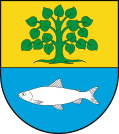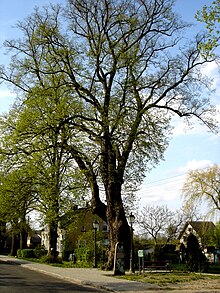Kobylanka (Powiat Stargardzki)
| Kobylanka | ||
|---|---|---|

|
|
|
| Basic data | ||
| State : | Poland | |
| Voivodeship : | West Pomerania | |
| Powiat : | Stargard | |
| Gmina : | Kobylanka | |
| Area : | 8.03 km² | |
| Geographic location : | 53 ° 21 ' N , 14 ° 52' E | |
| Residents : | 640 | |
| Postal code : | 73-108 | |
| Telephone code : | (+48) 91 | |
| License plate : | ZST | |
| Economy and Transport | ||
| Street : | DK 10 : Lubieszyn - Szczecin - Piła - Płońsk | |
| Ext. 120 : Gryfino - Stare Czarnowo - Kobylanka | ||
| Rail route : |
Poznań – Szczecin railway line Railway stations: Reptowo and Miedwiecko |
|
| Next international airport : | Szczecin-Goleniów | |
| Gmina | ||
| Gminatype: | Rural community | |
| Surface: | 122.05 km² | |
| Residents: | 5614 (June 30, 2019) |
|
| Population density : | 46 inhabitants / km² | |
| Community number ( GUS ): | 3214062 | |
| administration | ||
| Mayor : | Andrzej Kaszubski | |
| Address: | ul.Szkolna 12 73-108 Kobylanka |
|
| Website : | www.kobylanka.pl | |
Kobylanka (German Kublank ) is a village with the seat of a rural municipality of the same name in the Polish West Pomeranian Voivodeship and belongs to the powiat Stargardzki ( Stargard district in Pomerania ).
Geographical location
Kobylanka is located on the northeast bank of the Jezioro Miedwie ( Madüsee ) on the Polish state road 10 (former German Reichsstraße 104 ) from Lubieszyn ( Neu Linken ) / Germany ( Bundesstraße 104 ) via Piła ( Schneidemühl ) to Płońsk ( Plhnen ). It is 26 kilometers to the center of the voivodeship capital Szczecin , and the district town of Stargard ( Stargard in Pomerania ) is ten kilometers away.
Kobylanka is also the destination of 120 Voivodeship Road . It comes from the former district town of Gryfino ( Greifenhagen ) on the border with Germany ( Bundesstrasse 113 ) and Stare Czarnowo ( Neumark ).
Place name
The site is 1,203 years Kobank , 1304 Cobelanke and until 1945 Kublank called. A place called Kublank still exists in Mecklenburg-Western Pomerania today.
The Polish form of the name Kobylanka occurs four more times in Poland and also names two rivers.
Kobylanka village ( Kublank )
history
Before 1945, Kublank was a village in the Pomeranian district of Greifenhagen in the administrative district of Stettin in the Prussian province of Pomerania . District court area was Greifenhagen (today Polish: Gryfino).
In 1925 the place had 536 inhabitants, whose number rose to 645 by 1933 and was still 629 in 1939.
Kublank has had the name Kobylanka since 1945 and belongs to the Stargardzki powiat in the West Pomeranian Voivodeship (until 1998 Szczecin Voivodeship ). The place, in which today 640 inhabitants live, is today the district and official seat of Gmina Kobylanka.
church
Village church
Today's village church in Kobylanka is outwardly very different from the earlier church in Kublank. Until 1934 it was the oldest village church in Pomerania in the shape of a cross.
The half-timbered church burned down on May 24, 1934 , along with the slender, clapboard-roofed wooden tower from 1590, which was built on the west side. The tower was widened at the top, above it, with a slight curve and four windows, the octagonal helmet, free and clearly visible from afar as an excellent achievement of the best carpentry.
After 1945 the remains of the old church were enclosed in a new building, no longer in the half-timbered style and with the tower placed on the roof. The church is now called Kościół Św. Antoniego (z Padwy) ( St. Antonius Church). It was a Protestant church until 1945 and was expropriated in favor of the Catholic Church after the war .
Parish / Parish
It was not until 1892 that Kublank became an independent parish with its own parish , after all it had been a subsidiary parish of Belkow (now in Polish: Bielkowo). In 1940 the parish of Kublank counted 2,775 parishioners who lived in the branch parish of Moritzfelde (Morzyczyn), in the chapel parish of Barenbruch (Niedźwiedź) or in the parish towns of Brenkenhofswalde (Jęczydół), Karolinenhorst (Spaldingscowsfelde), and Karolinenhorst (Spaldingscowsfelde) in addition to Kublank.
The parish Kublank belonged until 1945 to the Kolbatz ( Kołbacz ) parish in the western district of the Pomeranian ecclesiastical province of the Protestant Church of the Old Prussian Union .
After the war - in 1949 - the Catholic Church in Kobylanka also established a parish. She was also assigned to the Deanery Kołbacz ( Kolbatz ) in the Archdiocese of Stettin-Cammin .
Pastor 1892–1945
In the 53 years as an independent parish, three evangelical clergy officiated in Kublank:
- Magnus Friedrich Samuel Matz, 1892–1919
- Detlev Rewald, 1920–1928
- Ernst Büchsel, 1928–1945.
Personalities: sons and daughters of the place
- Christian Heß (1803–1874), German school teacher, botanist and weather observer
Gmina Kobylanka
General
The rural municipality of Kobylanka covers 122.05 km², which corresponds to 8% of the total area of the powiat Stargardzki . 5,512 people live in the municipality. It belongs to the West Pomeranian Voivodeship and was part of the Szczecin Voivodeship until n1998 . The uniform postcode 73-108 applies throughout the municipality.
The northwestern part of the Jezioro Miedwie ( Madüsee ) belongs to the Gmina Kobylanka area . Neighboring communities are:
- Szczecin (independent city)
- Stargard ( Stargard in Pomerania ) (city) and Gmina Stargard in the powiat Stargardzki ( Stargard district ),
- Goleniów ( Gollnow ) in the powiat Goleniowski ( Gollnow district ), and
- Starlings Czarnowo ( Neumark ) in the Gryfiński powiat ( Greifenhagen district ).
Community structure
Gmina Kobylanka has 11 districts ( Schulzenämter ), to which other localities are assigned.
Districts
- Bielkowo (Belkow)
- Cisewo (Carpenter's Horst )
- Jęczydół (Brenkenhofswalde)
- Kobylanka (Kublank)
- Kunowo (Kunow a./Straße)
- Morzyczn (Moritzfelde)
- Motaniec (Spaldingsfelde)
- Niedźwiedź (Barenbruch)
- Rekowo (Reckow)
- Reptowo (Karolinenhorst)
- Destinationsiewo (Grünhof)
Other localities
- Gajęcki Ług (Great Gelüch)
- Kałęga (Kähling)
- Miedwiecko (Madüsee)
- Morwasko
- Wielichówko (Munsterberg)
- Zagość (jug)
traffic
Streets
The entire municipal area is covered by the provincial road 10 ( Lubieszyn ( Neu Linken ) - Stettin - Piła ( Schneidemühl ) - Płońsk ( Plhnen ), to Schneidemühl, the former German Reichsstrasse 104 ) and Voivodship road 120 (from Gryfino ( Greifenhagen ) - Stare Czarnowo ( Neumark )) opened up. Back roads or country roads lead to the few places in the north on the Puszcza Bukowa .
rails
A rail connection to the area of today's Gmina Kobylanka has existed since the construction of the Stettin - Stargard in Pomerania route in 1846, two years later it was extended to Poznan .
Two train stations on today's line 351 of the Polish State Railways are in the Kobylanka municipality: Reptowo ( Karolinenhorst ) and Miediwecko ( Madüsee ).
literature
- Johannes Hinz: Pomerania. Signpost through an unforgettable country . Bechtermünz, Augsburg 1996, ISBN 3-86047-181-3 .
- Hans Moderow : The evangelical clergy of Pomerania from the Reformation to the present . Part 1: The administrative district of Szczecin . Niekammer, Stettin, 1903.
- Heinrich Schulz: Pomeranian village churches east of the Oder. A book of memories . Beck, Herfort 1963.
Web links
Individual evidence
- ↑ population. Size and Structure by Territorial Division. As of June 30, 2019. Główny Urząd Statystyczny (GUS) (PDF files; 0.99 MiB), accessed December 24, 2019 .
- ↑ Sołectwa at kobylanka.pl.





